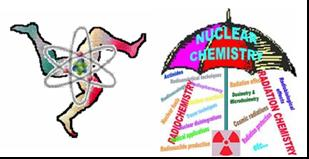Speaker
Mr
Kamil Brudecki
(The Henryk Niewodniczański Institute of Nuclear Physics, Polish Academy of Sciences)
Description
Plutonium isotopes are present in investigated samples mainly as a result of nuclear weapons tests in last century and Chernobyl disaster. In human body plutonium is accumulated mainly in liver and bones and main exposure pathway is inhalation. Bone tissue samples were obtained during routine surgeries – the replacement if knee or hip joints by implants. Patients belong to general population, not exposed in any special way to radioactive contamination. Surgeries were conducted in a V Military Hospital in Kraków in Southern Poland and in a general Hospital in Bielsk Podlaski in Northeastern Poland,. The patients originated from vicinity of hospital thus Pu from only Global Fallout was expected in case of Kraków and mixed Global and Chernobyl fallout was expected in case of Bielsk Podlaski. Studies got an approval of council for ethics in medical research.
Sampels were ashen in 600oC for two days. The ashes were gently soaked of 6M HCl. Precipitation of calcium oxalates at pH=3 was completed to obtain transuranic fractions. Calcium oxalates was dissolved of 1M HNO3. The oxidation state of Pu was adjusted to +4 using hydrazine and NaNO2 and after conversion into 8M HNO3, the fractions were passed through Dowex-1x8. Pu remains in the column was eluted using 50 ml. of 0.1M HF - 0.1M HCl. Alpha spectrometric Pu sources were prepared directly in the solutions using NdF3 method.
In Southern Poland in investigation involved 23 people, 9 men, 11 women, and 3 person who did not specified their gender in a quastionary. . The youngest patient was 56, while the oldest 88 years old. The obtained values for 239+240Pu activity ranged between 5.71.1 mBq kg-1 and 25.03.2 mBq kg-1. In all the samples 238Pu activity fell below the minimum detection activity, which was on the level of a single mBqkg-1, so suggesting global fallout as main source radioactive contamination in southern Poland. In case Northeastern Poland in study involved 25 people, 10 men and 15 women. Age range was between 32 to 85 years old. Minimum activity of 239+240Pu was equal to 5.41 mBq kg-1, whereas the maximum activity reached 34.35.7 mBq kg-1. In 6 samples 238Pu activity fell below the minimum detection activity, in rest activity was between 1.91.4 to 10.63.1 mBq kg-1. The measurable amounts of 238Pu suggest presence of traces of Pu of Chernobyl origin in bodies of inhabitants of Northeastern Poland.
Primary author
Mr
Kamil Brudecki
(The Henryk Niewodniczański Institute of Nuclear Physics, Polish Academy of Sciences)
Co-authors
Ms
Elżbieta Szczygieł
(Physical Therapy Department, Institute of Physical Therapy, Faculty of Heath Science, Jagiellonian University, Medical College)
Mrs
Ewa Tomankiewicz
(Orthopaedic Rehabilitation Department, Chair of Clinical Rehabilitation, Faculty of Motor of the Bronislaw Czech’s Academy of Physical Education)
Mr
Golec Edward
(Traumatology and Orthopaedic Clinic, 5th Military Clinical Hospital and Polyclinic, Independent Public Healthcare Facility)
Mr
Jerzy Mietelski
(The Henryk Niewodniczański Institute of Nuclear Physics, Polish Academy of Sciences)
Mrs
Joanna Golec
(Orthopaedic Rehabilitation Department, Chair of Clinical Rehabilitation, Faculty of Motor of the Bronislaw Czech’s Academy of Physical Education)
Mr
Konstanty Kuźma
(Traumatology and Orthopaedic Department, General Hospital in Bielsk Podlaski)
Mr
Sebastian Nowak
(Orthopaedic Rehabilitation Department, Chair of Clinical Rehabilitation, Faculty of Motor of the Bronislaw Czech’s Academy of Physical Education)




